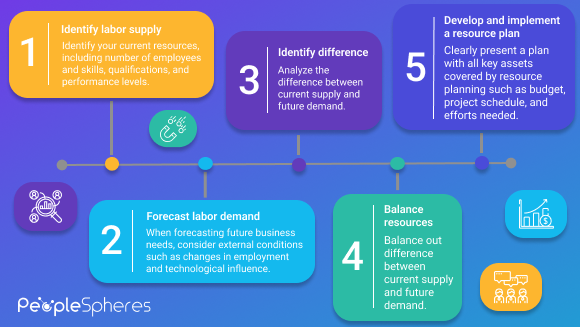-640x380.jpg)
Resource planning is defined as strategic planning to ensure that resources are allocated in the most productive way for a project to run as efficiently as possible. In human resources, resource planning focuses on the organization’s approach to optimizing the use of qualified employees for business functions and projects. This includes forecasting, planning, and allocating human resources to projects or tasks at the right time to ensure efficiency. Resources planning is closely aligned with the economic concept of supply and demand. If done correctly, business processes are optimized and are running at full capacity.
Related articles:
Learn How to Engage Employees in Each Stage of the Employee Life Cycle
A CHROS’s Guide to Formulating a Powerful Strategy
Advantages of Resource Planning Allocation
Visualize a workplace where no one knows what to do or when to do it. Project lifecycles are stretched over years because you are waiting weeks or months for resources required for the next phase of the project. Doesn’t seem like an efficient workplace, right? Resource planning practices prevent situations from these to happen. Resource allocation based on needs and business requirements allows a project manager to plan and allocate the most skilled staff for the job while identifying if there is a need for a particular talent in the future. Resource planning is essential to ensure that the business is running at full capacity, which is an important part to maximize business profitability. Except for the overlooking advantage of resource planning, it also comes with several advantages that improve other areas of human resource management:
Performance Management and Retention of Talent
According to ISG in 2021, most organizations are incapable to forecast talent needs, providing insights into skills and capabilities for the future, or linking talent planning to business planning.
Proper resource planning allows upper management to identify performance and talent within the company that brings business value, which promotes sustainable scalability. It fosters enterprise performance management as it allows managers to train and develop staffing based on business needs, which increases the chance of retaining top talent.
Talent that is nurtured and put into use is more likely to stay with a company than talent that is not properly handled. It also supports the steady retention of talent, as the supply and demand of resources will be monitored and helps managers to keep track of the need for specific talents.
Cost Effective
Human resource planning also reduces costs. As resources are properly allocated and talent within the company is utilized to its maximum, the cost of attracting and keeping the workforce decreases. With proper enterprise resource planning, budgeting becomes more efficient and accurate.
Accelerates Processes
Ensuring that the right resources are ready and allocated at the right time is an important part of project management and ensures a shorter project lifecycle. With accurate resource allocation as a milestone that is never neglected in project planning, management processes are running at full capacity and results accelerate.
HR Outsourcing
HR outsourcing is a growing industry, and today, more than two-thirds of businesses implement HR outsourcing for professional services. According to Sapient Insight Group in 2022, 50 percent of buyers are planning to change their payroll, time, and analytics in the coming 2 years.
Outsourcing helps you spend more time on strategic and critical tasks as you pay others to do repetitive, low-value-added tasks for you. With the help of resource planning, you can forecast and plan business needs and identify business functions where it would be beneficial to outsource. There are multiple factors to consider when implementing HR outsourcing, including:
-
Outsource low valued-added, non-strategic activities first
-
Carefully choose a partner and tasks assigned
-
Choose a partnership where you are allowed to closely monitor and manage your service
Loan of Employees Between Companies
More companies are starting to consider a modern branch of HR outsourcing: the loan of employees between companies. The modern-day solution saves time and money, promotes flexibility, and supports the need for employees for a short duration. Enterprise resource planning allows you to identify and track human resources needed for projects, which opens possibilities for the loan of employees. If you have an excess of supply, you can start reaching out to other companies if they are interested in a borrowed employee. If you have more demand than supply of human resources for coming projects, the loan of employees might be a solution to consider.
Under-Utilization of Resources
Without a resource planning system that calculates resource demand and supply and performs capacity planning, under-utilization is bound to happen. Under-utilization of resources refers to a situation where resources are in-effectively used and are not running at their full capacity. This situation reduces profitability and business performance.
Redefining Productivity
Under-utilization hurts business productivity. According to Gary Hamel from the Management Lab, we need to redefine productivity for organizations to reach their full potential. Hamel explains bureaucracy and how it is costing the global economy trillions as its stripping employees of their passion, creativity, and innovative thinking. Accurate resource planning practices increase productivity and are a step in the right direction to decreasing excess bureaucracy.
How to Create the Perfect Plan
When creating the perfect plan for your human resources, start by dividing it into 5 main steps:
-
Identify labor supply
-
Forecast labor demand
-
Analyze the difference between supply and demand
-
Balance resources accordingly
-
Develop and implement a resource plan
Identification of Resources
In steps 1 and 2, you need to identify your current resources and forecast demand. A resource planner tool is recommended to streamline the business process and increase visibility. The identification of resources includes detecting current and future needs of the number of employees and skills, qualifications, and performance levels. When forecasting future business needs, remember to consider conditions that would impact your workplace such as changes in employment and technological influence. After the supply and demand of resources have been identified, the difference between the two needs to be analyzed and balanced out.

Development of Plan
Once resources have been identified, it is time for the project team to start with resource scheduling. This should be presented and implemented in a resource plan that clearly and concisely presents a roadmap with all important assets covered by resource planning such as budget, project schedule, and efforts needed. During the development of the resource plan, the team should have open communication with their employees. The employees are the human resource discussed and the best source to gain any relevant information needed when forming the plan. Therefore, make sure to collaborate with employees and keep an open line of communication between parties.
Rightsizing
Rightsizing is the process of restructuring an organization to improve efficiency and performance by aligning the workforce with its current needs and goals. It involves adjusting staffing levels, reallocating resources, and enhancing agility to better adapt to market demands.
The key benefits of rightsizing include improved efficiency, cost management, competitiveness, employee morale, and strategic alignment. The process involves assessing the workforce, defining objectives, and developing a clear plan, followed by transparent communication and support for employees. Technology plays a vital role in streamlining rightsizing, offering data insights, automating tasks, and enabling flexible work arrangements.
Digitalization of Resource Planning
To ensure that your human resources department is operating efficiently in all areas, it is important that you stay on top of technology trends to avoid operating with a legacy system. According to Sapient Insights Group in 2022, 54 percent of companies with over 500 employees are increasing their HR tech spending by an average of 21 percent. If you are looking for a cloud solution to upgrade your resource planning system, there are numerous resource planning software solutions available on the market.
Employee resource management (ERM) applies the techniques of customer relationship management to current or potential employees of a company. The management tool is resource planning’s response to the digitalization of HR and responds to current issues such as the battle for talent, the hunt for well-being at work, and the arrival of younger generations in the workplace.
Software Automation
PeopleSpheres, the configurable, cloud-based employee resources management software solution, automates and streamlines resource planning by connecting HR management tools in one place. The software applications unify all HR software systems and tasks within a single portal to simplify everyday planning and HR workload. By having all management systems on a centralized platform, you remove the issue of needing hundreds of passwords to access different systems with disparate data.
To enhance this streamlined experience, tools like Jira templates can be integrated into workflows, providing pre-defined frameworks for various HR and project management tasks. These templates support consistency and efficiency, making it easier for teams to align their processes with strategic goals.
With PeopleSpheres, agile integrations and connectors streamline your HR experience by allowing you to seamlessly navigate between the different management solutions on a single dashboard when planning your human resources. The software is an intuitive, easy-to-use tool that promotes collaboration and customization and helps you automate administrative tasks through workflows which allows your managers to focus on key business processes and strategic approaches.
Conclusion
Resource planning is the practice of allocating resources to the right place at the right time, which includes forecasting, planning, and analyzing.
There are numerous benefits to human resource planning, with the main ones being increased productivity and streamlining of operations. With proper resource planning, you can also expect your financials to improve as less cost needs to be spent on acquiring and keeping talent.
Business management systems offer resource management software implementation that can be used to optimize your resource planning practices no matter if you are a small business looking to modernize and upgrade your current systems, a midsize company growing by acquisition, or a global firm that is in the need of a more complex management solution. With modern HR technology, resource planning will be streamlined.





